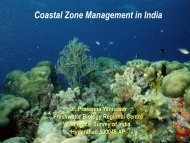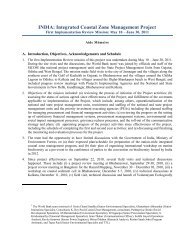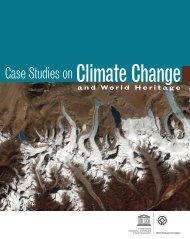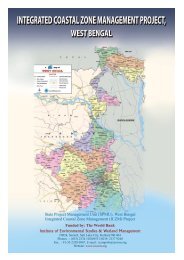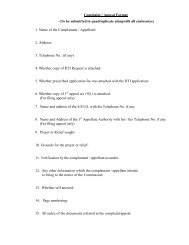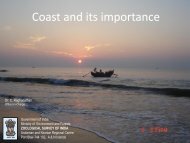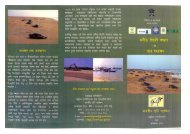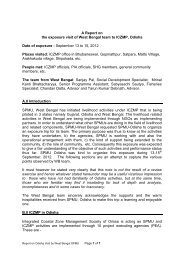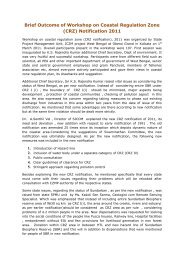Cyclone and Storm Surge - Iczmpwb.org
Cyclone and Storm Surge - Iczmpwb.org
Cyclone and Storm Surge - Iczmpwb.org
You also want an ePaper? Increase the reach of your titles
YUMPU automatically turns print PDFs into web optimized ePapers that Google loves.
2.18<br />
All rivers have in general southerly course towards sea. Some of the above major rivers braids into<br />
more than one channel before meeting the sea. Except river Hooghly <strong>and</strong> river Baratala all rivers are<br />
actually tidal waterways without any upl<strong>and</strong> discharge expecting run off of small localised catchment<br />
<strong>and</strong> their water is as salty as the sea.<br />
Between the large estuaries <strong>and</strong> rivers are innumerable streams <strong>and</strong> water courses called khals,<br />
forming a net-work of channels, some ending ultimately in little channels that serve to draw off the<br />
water from each block of l<strong>and</strong>. Each block is formed like a saucer with high ground along the bank of<br />
the Khals surrounding it, <strong>and</strong> with one or more depressions in the middle. The rain water in the block<br />
is drained off by the little khals into the larger khals <strong>and</strong> ultimately to the Sea through the rivers during<br />
Ebb tide, conversely when the water swells in the rivers during Flood tide it floods the country<br />
through the same channels. Many of the khals connect two large ones, <strong>and</strong> consequently the tide<br />
flows into them through both ends. Such khals are called “Do-Aniya" Khals. They are very useful as<br />
affording communication between the larger khals, but have one serious defect that they are liable to<br />
silt up at the point where the two tides meet, for the water in always still there.<br />
Even the major rivers in the Sundarban region flowing East of the Hooghly river have relatively small<br />
catchment areas <strong>and</strong> consequently the discharges from the hinterl<strong>and</strong>s are small in comparison with<br />
the volumes of water which flow in <strong>and</strong> out each tide. Therefore, the currents in the maze of rivers<br />
<strong>and</strong> creeks of the Sundarban Region are almost entirely the results of the fluctuation of the sea level<br />
in the Bay of Bengal <strong>and</strong> the way these fluctuations propagate themselves within the system of<br />
waterways of the delta.<br />
2.4.8. Tides<br />
Tides are generated in the Bay of Bengal by the forces of attraction of mainly the sun <strong>and</strong> the moon<br />
upon the rotating earth. The effect of tide is manifested in a regular alteration of rise <strong>and</strong> fall of the<br />
water level of the sea <strong>and</strong> the estuarine channels <strong>and</strong> creeks, with the advent of rising tide, the water<br />
level of the Sea Starts rising gradually <strong>and</strong> steadily till a highest level known as the “High Water<br />
Level” (HWL) is attained. This rising phase of the tide is called the “Flood tide” or the “Flow tide”.<br />
After the attainment of HWL the tide water level starts falling gradually <strong>and</strong> steadily till a lowest water<br />
level (LWL) is reached. This falling phase of the tide is called “Ebb tide”. Thereupon the tide water<br />
starts rising once again till the occurrence of the next HWL <strong>and</strong> so on. The difference in elevation<br />
between a HWL <strong>and</strong> the next LWL is called the “Tidal range” <strong>and</strong> the period intervening any two







